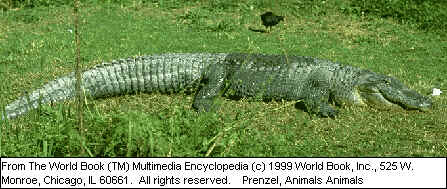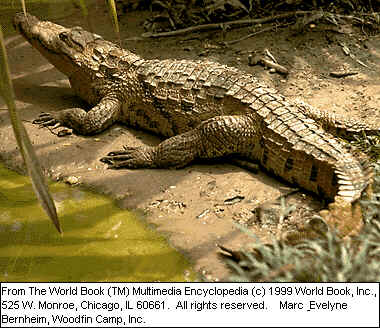| Alligator, Crocodile, Caiman |
| Alligator Spanish el lagarto,
the lizard, common name for two carnivorous reptiles in
the crocodilian order. Alligators and their close
relatives the caimans have broad, flat, and rounded
snouts, as opposed to the longer, sharper snouts of other
crocodilians; also unlike other crocodilians, their lower
teeth cannot be seen when their mouths are closed.
Alligators feed on fish, frogs, snakes, turtles, birds,
mammals, and carrion. In North America they are also
known to attack humans occasionally. Alligators can
survive a wider range of temperatures than other
crocodilians, and they are found in more temperate
regions. Their breeding season is generally restricted to
spring. When alligators search for a mate they bellow
often, perhaps to announce their presence to females and
to warn other males to stay away. Unwanted intruders are
confronted with ritual gaping, lunging, and hissing, but
courtship behavior is sedate. After mating, the male
seeks his own territory while the female builds a nest of
mud and plants nearby, above flood level. The eggs, from
30 to 60 in a clutch, are covered with mud and
vegetational debris. The female stands guard as the eggs
incubate in the heat from this decaying vegetation and
from the sun. When the eggs are ready to hatch, in about
60 days, the young begin to croak softly within the egg.
The female may then assist the young in escaping from the
nest and may even carry them in her mouth to the water's
edge. The female may remain near her young for a year or
more. A young alligator in distress will give a series of
sharp croaks that may quickly bring the female to
investigate. Only two species of alligator exist: the
Chinese alligator and the American alligator. The Chinese
alligator makes its home in the Yangtze River Basin of
China. It is more timid and much smaller than the
American alligator, seldom exceeding 2.5 m (8 ft) in
length, and is considered little threat to humans. The
American alligator lives mainly in freshwater swamps,
lakes, and bayous in the southeastern United States, but
it ranges as far west as the Rio Grande in Texas. It is
larger, reaching up to about 6 m (about 20 ft) in length,
and is potentially dangerous to humans. Attacks occur
infrequently, usually in areas where humans have recently
encroached on alligator habitat or where alligators have
become accustomed to the presence of humans. Hunted for
generations both for sport and for its hide, populations
of the American alligator dwindled until, in 1967, it was
declared an endangered species. Under this protection it
made a strong comeback and, little more than a decade
later, hunting of the American alligator was again
allowed in some states. Crocodile Caiman Scientific
classification: Alligators constitute the genus
Alligator, family Crocodylidae. They are sometimes
recognized as a separate family, Alligatoridae. The
Chinese alligator is classified as Alligator sinensis and
the American alligator as Alligator mississipiensis.
Contributed By: James A. Oliver "Alligator,"
Microsoft Encarta 98 Encyclopedia. 1993-1997 Microsoft
Corporation. All rights reserved.
Alligator is the name of two kinds of reptiles
related to crocodiles. The American alligator lives in
the waters and lowlands of southeastern United States.
The Chinese alligator lives in the lower Yangtze River
Valley, in China. Other closely related reptiles are the
caymans of Central and South America. Caymans are often
called alligators.
Crocodile (reptile, common name for any of a number of reptiles in a family of the crocodilian order. The term refers to all members of the order, which includes as well as crocodiles. Crocodilians first appeared about 200 million years ago and are believed to be remnants of the great age of reptiles. Their ancestors originally lived on land and were lightly built, but they soon diversified into water-dwelling, or aquatic, and amphibious forms. Except for the alligators, crocodilians live in tropical and subtropical areas of the world. Modern crocodilians are amphibious, spending much of their time in water, where they swim with rhythmic strokes of the tail. The tail is sometimes used to capture prey, sweeping it from shallow to deeper water, where it can be devoured more easily. Crocodilians are well-adapted as predators, with few natural enemies. Bony plates, called osteoderms, form a kind of armor in their thick skin. Their teeth, about 30 to 40 in each jaw, are set into sockets in the jawbones and interlock when the mouth is closed. In crocodiles, the fourth tooth on each side of the lower jaw protrudes when the mouth is closed; in alligators, these teeth are not visible. The jaws of crocodilians are powerful enough in closing to crush the bones of small animals, but so weak in opening that they can be held together by hand. As the crocodilian floats almost completely submerged, its protruding nostrils and eyes and a portion of its back are the only parts visible as it stalks its prey. Crocodilians are the most vocal reptiles, producing sounds from quiet hisses to fearsome roars and bellows, usually during the mating season. On land, crocodilians move quickly in a belly crawl but can also gallop and walk mammal-like on all four legs. Crocodiles are physiologically the most advanced reptiles; their internal anatomy resembles that of birds. They have a four-chambered heart and well-developed senses. Cold-blooded like all reptiles '97their body temperature depends on the environment '97crocodilians bury themselves in mud to estivate or hibernate. In warm regions they are dormant during droughts; in colder regions, during winter. Crocodilians are egg-laying, or oviparous, reptiles, reaching reproductive maturity at about the age of ten. The eggs, 20 to 90 in number and about the size of goose eggs, are buried in sand, mud, or vegetable debris, where they are left to hatch by the heat of the sun or of vegetable decomposition. Females of some species remain in the area to protect the nest and care for the newly hatched young, although many of the eggs and young are lost to predators. The parental behavior of crocodilians is unique among reptiles and points to their affinity with birds. The Crocodile Some members of the crocodile family are the largest living reptiles. Crocodiles usually can be recognized by their long triangular snouts, intermediate between the long, narrow snouts of gavials and the short, oval snouts of alligators and caimans. The Indo-Pacific, or saltwater, crocodile, possibly the largest living reptile, is known to grow to a length of about 7 m (about 23 ft) and to weigh more than 1000 kg (more than 2000 lbs); there are unconfirmed reports of individuals up to 9 m (up to 30 ft) in length. This species inhabits the coastal waters of India, southern China, and Malaysia. A smaller species, the swamp crocodile, or mugger, is found in inland waters of India. The Nile crocodile of Africa was revered by certain ancient Egyptian sects, and mummies of crocodiles have been discovered in Egyptian tombs. In modern times this species has been hunted so extensively that few individuals remain in the lower Nile, but they are still abundant in the upper Nile and southward in Africa to the Cape of Good Hope. In the Americas there are four species of crocodiles. The Cuban crocodile, which has a relatively short snout and reaches about 3.5 m (about 11.5 ft) in length, is restricted to Cuba and the Isla de la Juventud. Morelet's crocodile, comparable in size to the Cuban crocodile, occurs along the Gulf Coastal Plain and Yucat\'e1n Peninsula of southern Mexico, Belize, and Northern Guatemala. The Orinoco crocodile inhabits drainages of the Orinoco River system and grows to about 6 m (about 20 ft). The American crocodile, the largest crocodile in the Americas, reaches lengths of about 7 m (about 23 ft) and inhabits a broad range from southern Florida southward, including Cuba and other Caribbean islands, southern Mexico, Central America, and northern South America. Crocodile eggs are used for food in some parts of the world. The skin is highly valued for leather, and the extract from the musk glands is used in the manufacture of perfumes. Due to overhunting, most crocodiles\'97including the American and Nile crocodiles\'97are considered endangered species. Scientific classification: Crocodiles belong to the genera Crocodylus, Osteolamus, and Tomistoma of the family Crocodylidae, order Crocodylia. The Indo-Pacific crocodile is classified as Crocodylus porosus, the swamp crocodile as Crocodylus palustris, the Nile crocodile as Crocodylus niloticus, the Cuban crocodile as Crocodylus rhombifer, the Morelet's crocodile as Crocodylus moreletii, the Orinoco crocodile as Crocodylus intermedius, and the American crocodile as Crocodylus acutus."Crocodile (reptile)," Encarta 98 Encyclopedia. 1993-1997 Microsoft Corporation. All rights reserved.
Crocodile is one of the largest living
reptiles. Crocodiles, alligators, gavials, and caymans
look much alike, and are all called crocodilians. Both
crocodiles and alligators have a long, low, cigar-shaped
body, short legs, and long powerful tails with which they
swim. They both have tough hides, long snouts, and sharp
teeth to grasp their prey. In most crocodiles, however,
the snout comes to a point in front, where an alligator's
snout is rounded. The American crocodile is only about
two-thirds as heavy as an old American alligator of the
same length and can move much more quickly. The lower
fourth tooth is extra long in both animals. It fits into
a pit in the alligator's upper jaw. But the crocodile's
fourth tooth fits into a groove in the side of the upper
jaw, and it is visible when the animal's jaws are closed.
Caiman Cayman, common name for three genera of reptiles in the crocodilian order. They closely resemble alligators except for the small bony scales, or osteoderms, embedded in the skin of their bellies. All are found in the American Tropics. The largest '974.5 m (15 ft) or more in length\'97is the black caiman of the Orinoco and Amazon rivers; it is in danger of extinction, as are many other crocodilians. The smallest caiman, about 1.5 m (about 5 ft), is Cuvier's dwarf or armored caiman, which has heavily ossified, or bony, skin. One of the most abundant and wide-ranging is the spectacled caiman, named for the bony ridge between its eyes, which looks like the nosepiece of a pair of eyeglasses. See Crocodile. Scientific classification: Caimans belong to the family Alligatoridae in the order Crocodylia. The black caiman is classified as Melanosuchus niger, the armored caiman as Paleosuchus palpebrosus, and the spectacled caiman as Caiman crocodilus crocodilus."Caiman," Microsoft Encarta 98 Encyclopedia. 1993-1997 Microsoft Corporation. All rights reserved.
|
| Scott's Internet Hotlist |




